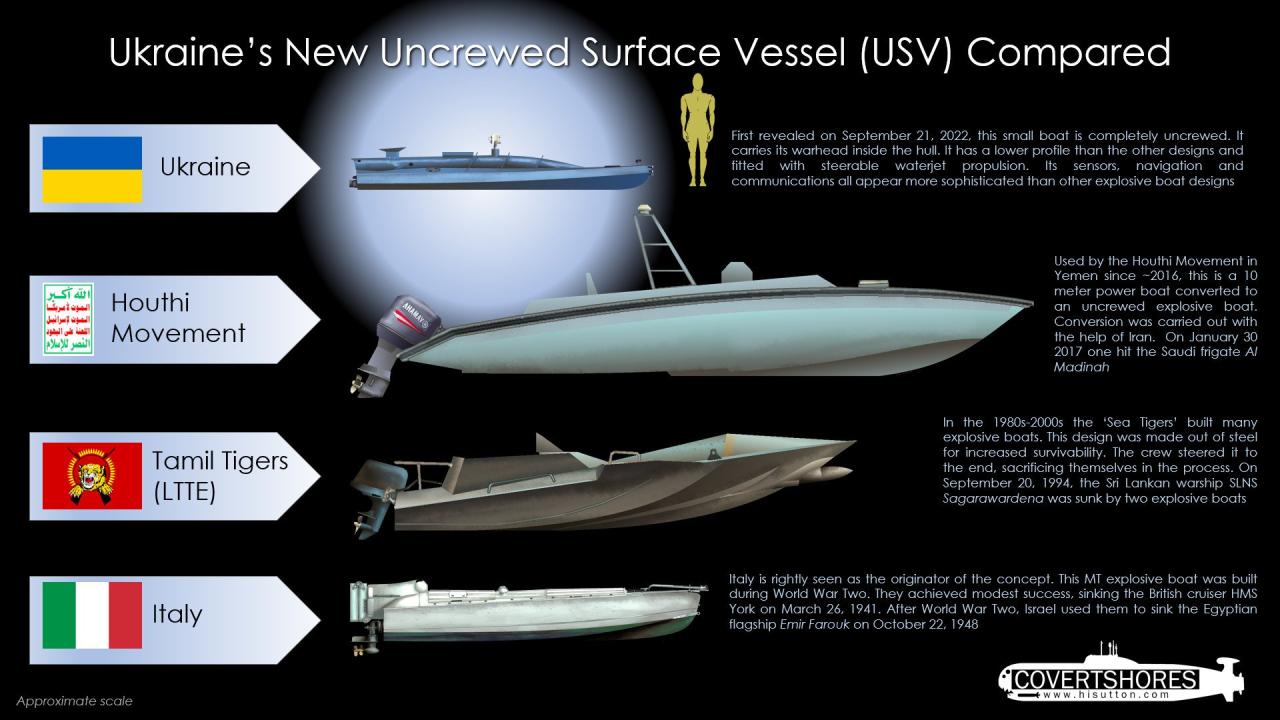Ukrainian sea drones are rapidly changing naval warfare. These unmanned vessels, ranging from small, expendable craft to more sophisticated autonomous systems, are proving surprisingly effective in the ongoing conflict. This exploration delves into their design, capabilities, military applications, manufacturing processes, international implications, and future potential. We’ll cover everything from the materials used in their construction to the ethical considerations surrounding their deployment.
From their initial deployment in relatively simple reconnaissance roles, Ukrainian sea drones have evolved to become potent weapons capable of striking targets with precision. Their effectiveness stems from a combination of factors: relative affordability, ease of deployment, and adaptability to various mission profiles. We will examine successful deployments, analyze their limitations, and discuss potential countermeasures.
Ukrainian Sea Drone Technology
Ukraine’s development of sea drone technology represents a significant advancement in asymmetric warfare capabilities. Driven by necessity in the ongoing conflict, Ukrainian engineers have rapidly innovated, producing a range of drones with varying capabilities, from small, expendable craft to larger, more sophisticated platforms. This technology is not only impacting the current conflict but also reshaping the global landscape of naval warfare and the arms trade.
Ukrainian sea drones are proving to be surprisingly effective, showcasing the adaptability of drone technology in military applications. Think about the sheer scale and precision needed, then compare that to something like the dazzling light shows you see in the china new year drone show ; it highlights how far drone coordination has come. The lessons learned from civilian drone displays, like the intricate choreography of the Chinese New Year event, can even inform the development of more sophisticated autonomous naval drones.
Current State of Ukrainian Sea Drone Technology
Ukrainian sea drone technology is characterized by its adaptability and relatively low cost. Designs often prioritize simplicity and ease of production, enabling rapid deployment and replacement. Capabilities range from reconnaissance and surveillance to direct attack, leveraging various payloads including explosives and sensors. The focus is on achieving maximum impact with readily available materials and technology.
Types of Ukrainian Sea Drones
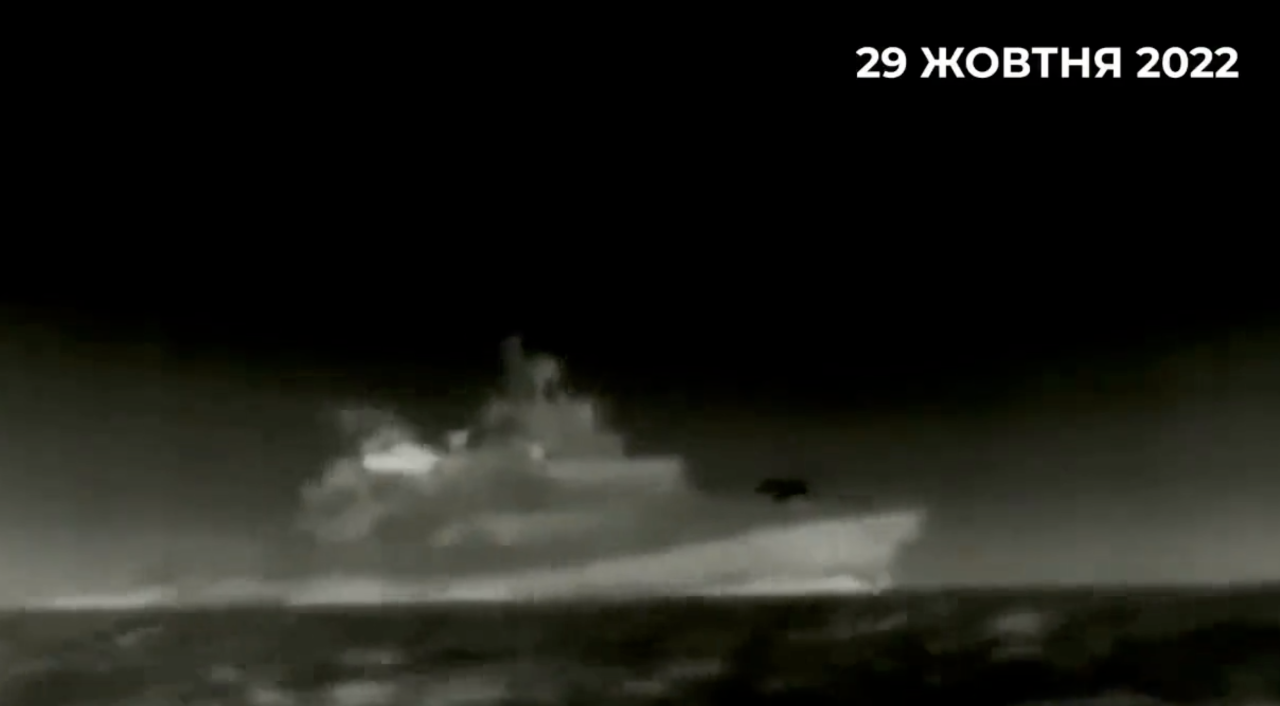
Several types of Ukrainian sea drones are in use or under development. These vary significantly in size, payload capacity, and range. Some are small, expendable units ideal for swarm attacks, while others are larger, more durable platforms capable of carrying heavier payloads and operating at longer ranges. Specific details on individual models remain largely classified for operational security reasons.
Comparison with Other Nations’ Sea Drone Technology
Compared to the sophisticated, large-scale autonomous underwater vehicles (AUVs) developed by major naval powers like the US, UK, and China, Ukrainian sea drones emphasize affordability and rapid production over advanced AI or sophisticated sensor integration. While lacking the advanced features of their counterparts, the Ukrainian approach leverages simplicity and mass deployment as a key strategic advantage.
Materials and Performance
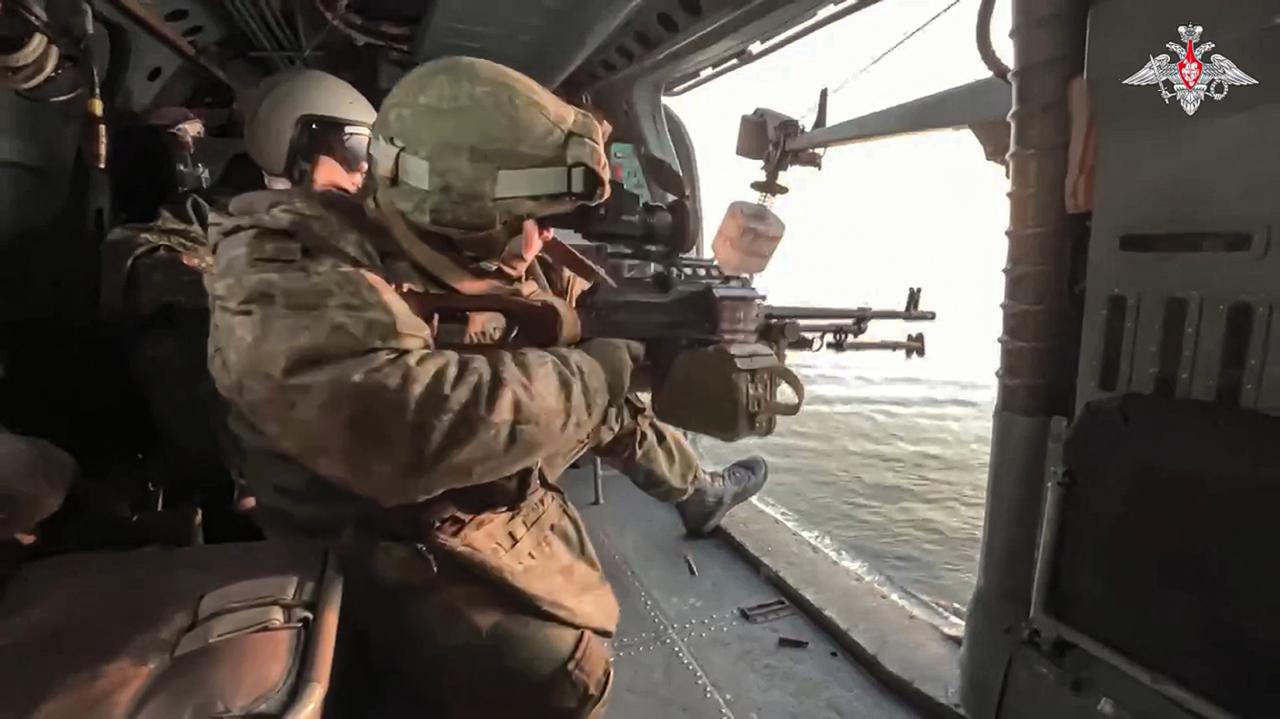
The construction of Ukrainian sea drones often utilizes readily available and relatively inexpensive materials. This focus on affordability allows for mass production and rapid replenishment. While specific materials remain undisclosed, it is likely that a combination of readily sourced plastics, composites, and commercially available electronics are employed. The impact on performance is a trade-off between cost-effectiveness and the longevity and advanced capabilities of more expensive materials.
Comparison of Ukrainian Sea Drone Models
| Model | Speed (knots) | Range (km) | Payload (kg) | Targeting System |
|---|---|---|---|---|
| Model A (Hypothetical) | 15 | 50 | 50 | GPS-guided |
| Model B (Hypothetical) | 20 | 100 | 100 | GPS & inertial navigation |
| Model C (Hypothetical) | 10 | 200 | 200 | Pre-programmed route |
Military Applications of Ukrainian Sea Drones
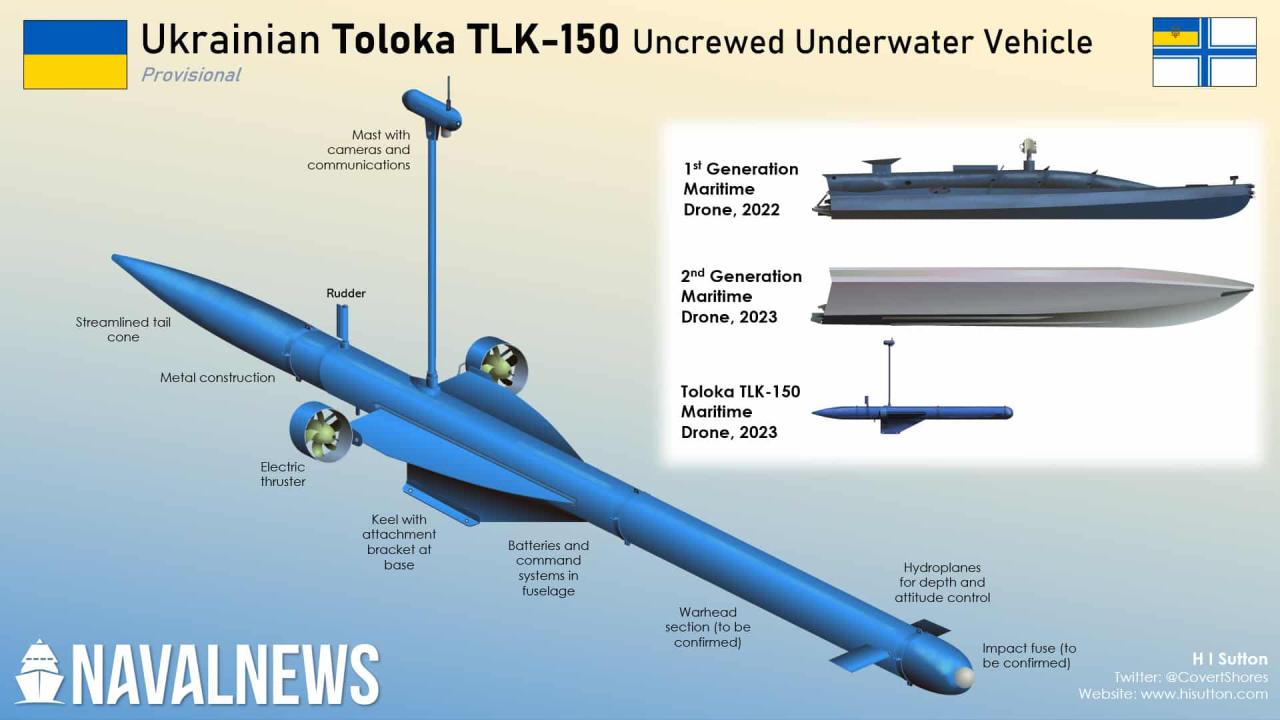
Ukrainian sea drones have found diverse applications in naval warfare, significantly impacting both tactical and strategic operations. Their effectiveness stems from their affordability, ease of deployment, and adaptability to various mission profiles.
Tactical and Strategic Uses in Naval Warfare
Tactically, Ukrainian sea drones are employed for anti-ship attacks, reconnaissance, and mine-laying operations. Strategically, their use contributes to the overall naval power balance, forcing adversaries to dedicate resources to countermeasures. The ability to deploy numerous drones simultaneously significantly increases the risk to enemy vessels and coastal installations.
Successful Deployments in Recent Conflicts
While specific details of successful deployments are often kept classified, reports suggest that Ukrainian sea drones have been instrumental in damaging or destroying several Russian naval vessels and coastal infrastructure. The effectiveness of these deployments highlights the potential of low-cost, expendable drones in asymmetric warfare.
Reconnaissance and Surveillance
Ukrainian sea drones are valuable assets for reconnaissance and surveillance missions. Their small size and quiet operation allow them to approach targets undetected, gathering intelligence on enemy movements and deployments. This intelligence can then be used to inform more decisive actions.
Vulnerabilities and Countermeasures
Potential vulnerabilities include susceptibility to electronic warfare, detection by radar and sonar, and physical damage from enemy fire. Countermeasures include the use of electronic countermeasures, stealth technologies, and swarm tactics to overwhelm enemy defenses. The low cost of the drones allows for acceptable losses during operations.
Hypothetical Swarm Drone Scenario, Ukrainian sea drone
Imagine a scenario where a swarm of 50 Ukrainian sea drones is deployed against a Russian naval task force. The drones, operating autonomously or semi-autonomously, approach the task force from multiple directions. Some drones act as decoys, drawing fire, while others target specific vessels, using their payloads to inflict damage. The swarm’s decentralized nature makes it difficult for the enemy to effectively counter the attack.
Manufacturing and Procurement of Ukrainian Sea Drones
The process of manufacturing and procuring Ukrainian sea drones is characterized by its adaptability and reliance on both domestic and international collaboration. The focus is on rapid production and deployment, utilizing readily available components and materials.
Manufacturing Process
The manufacturing process likely involves a combination of domestic and potentially international suppliers for components. Production is likely distributed across multiple facilities to enhance resilience and security. The emphasis is on simplicity and ease of assembly, enabling rapid scaling of production to meet operational demands.
Ukrainian sea drones are making waves, showcasing impressive autonomous capabilities in naval warfare. Think of the precision and coordination involved – it’s a far cry from the dazzling, synchronized light shows you see at events like the shanghai drone show , but both highlight the incredible potential of drone technology. The same principles of autonomous navigation and swarm behavior apply, just with very different goals; one’s for defense, the other’s for entertainment, but both are pushing the boundaries of what drones can do.
Key Players
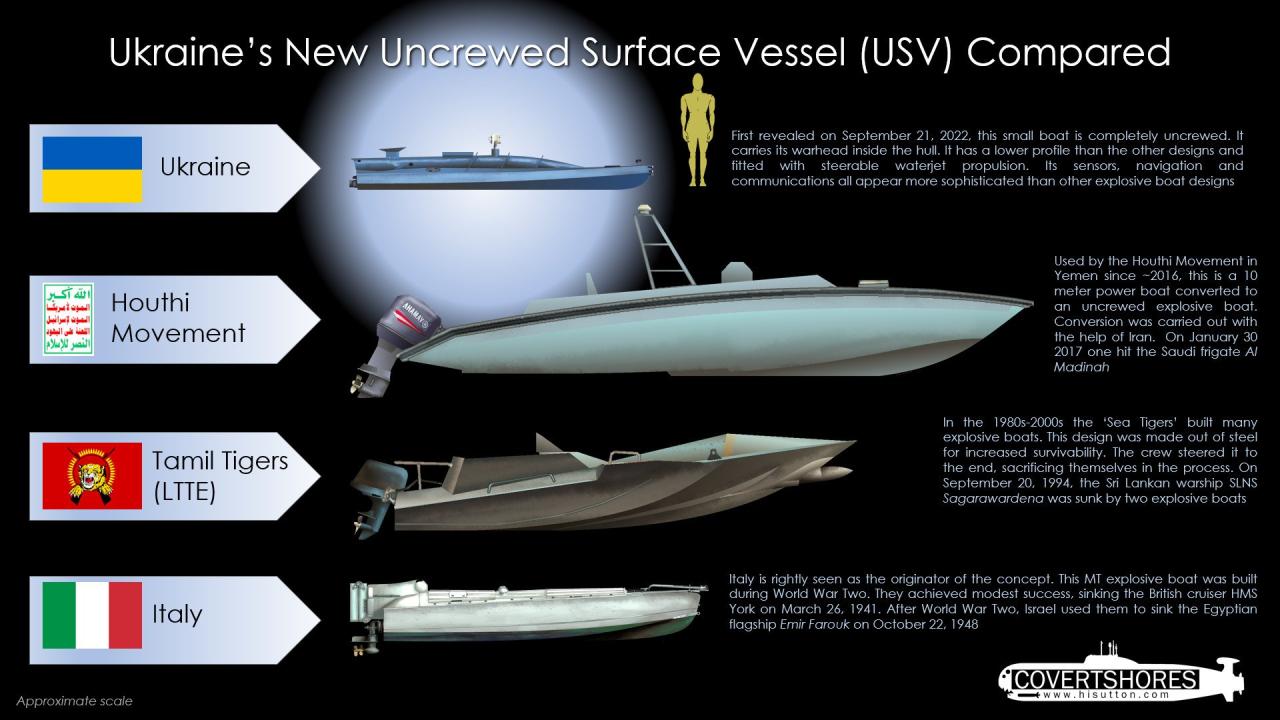
Key players in the production and supply chain include Ukrainian defense companies, private sector technology firms, and potentially international partners contributing to specific components or technologies. Precise details on the involvement of specific entities are generally not publicly available.
Funding Mechanisms
Funding for the development and procurement of Ukrainian sea drones likely comes from a combination of government funding, international aid, and private investment. The exact breakdown of funding sources is not publicly disclosed.
Stages of Development
- Concept and design
- Prototype development and testing
- Production ramp-up
- Deployment and operational use
- Ongoing refinement and improvement
Cost-Effectiveness
Ukrainian sea drones offer a significant cost advantage compared to traditional naval assets. Their low unit cost allows for mass deployment, making them a highly effective tool in asymmetric warfare scenarios where overwhelming numbers can compensate for individual limitations.
International Implications of Ukrainian Sea Drone Technology
The emergence of Ukrainian sea drone technology has significant implications for the global arms trade, international relations, and the ethical considerations surrounding autonomous weapons systems.
Impact on the Global Arms Trade
The success of Ukrainian sea drones is likely to increase the demand for similar technologies globally. Countries with limited naval budgets may find these drones an attractive and cost-effective alternative to traditional naval assets.
Ukrainian sea drones are making waves, showcasing impressive capabilities in naval warfare. It’s a far cry from the dazzling light shows you’d see at a large-scale drone event like the shanghai drone show , but both highlight the rapid advancements in drone technology. The precision and adaptability of Ukrainian sea drones, however, are proving crucial in a very different kind of operation.
Potential for Proliferation
The relatively simple design and production of Ukrainian sea drones raise concerns about the potential for proliferation to other countries, including those with less stringent export controls or potentially less ethical intentions.
Ethical and Legal Considerations
The use of autonomous weapons systems, including sea drones, raises complex ethical and legal questions regarding accountability, proportionality, and the potential for unintended consequences. International regulations and agreements are still evolving to address these concerns.
Impact on International Relations and Naval Power Balances
The widespread adoption of Ukrainian-style sea drone technology could significantly alter naval power balances, particularly impacting the capabilities of smaller naval forces. This could lead to a reassessment of naval strategies and doctrines globally.
Benefits and Risks of Wider Adoption
- Benefits: Increased cost-effectiveness for smaller navies, enhanced asymmetric warfare capabilities, improved reconnaissance and surveillance.
- Risks: Potential for proliferation to non-state actors, escalation of conflicts, ethical concerns surrounding autonomous weapons systems.
Future Developments in Ukrainian Sea Drone Technology
The future of Ukrainian sea drone technology promises significant advancements in autonomy, intelligence, and lethality. Ongoing innovation will likely focus on enhancing capabilities while maintaining cost-effectiveness.
Future Trajectory
Future development will likely focus on increased autonomy, improved sensor integration, enhanced payload capabilities, and the incorporation of artificial intelligence for more sophisticated mission planning and execution. Miniaturization and improved stealth capabilities are also likely areas of focus.
Areas of Innovation
Key areas of innovation include the development of more advanced AI for autonomous navigation and target recognition, improved underwater capabilities for enhanced stealth and operation in challenging environments, and the integration of more sophisticated sensor systems for improved situational awareness.
AI and Autonomous Systems Integration
The integration of AI and autonomous systems will be crucial for future development. This will enable drones to operate more independently, reducing the reliance on human operators and increasing their effectiveness in complex and dynamic environments.
Hypothetical Advanced Features
Future designs might incorporate advanced features such as improved acoustic and optical sensors for enhanced target detection, advanced AI-powered decision-making systems for autonomous mission execution, and enhanced countermeasures against electronic warfare.
Potential Future Advancements
| Feature | Current (Hypothetical) | Future (Hypothetical) |
|---|---|---|
| Speed (knots) | 20 | 30+ |
| Range (km) | 100 | 500+ |
| Payload (kg) | 100 | 200+ |
| AI Integration | Basic GPS guidance | Advanced autonomous navigation and target recognition |
Ultimate Conclusion
Ukrainian sea drone technology represents a significant shift in naval power dynamics. Their cost-effectiveness and adaptability make them a compelling force multiplier, potentially influencing future naval conflicts and the global arms trade. While challenges remain – including potential for proliferation and ethical concerns – the ingenuity and innovation behind these drones are undeniable, paving the way for further advancements in unmanned naval capabilities.
FAQ Guide: Ukrainian Sea Drone
What is the lifespan of a typical Ukrainian sea drone?
Lifespan varies greatly depending on the model and mission. Some are designed for single-use attacks, while others are intended for multiple deployments before needing maintenance or replacement.
How are Ukrainian sea drones guided and controlled?
Control methods range from pre-programmed missions to real-time operator control via satellite or other communication links. More advanced models may incorporate AI for autonomous navigation and target acquisition.
What types of payloads can Ukrainian sea drones carry?
Payloads can include high explosives, smaller ordnance, sensors for reconnaissance, or electronic warfare equipment.
Are Ukrainian sea drones easily detectable?
Detectability varies depending on the model and the countermeasures employed. Smaller drones can be harder to detect than larger ones, and stealth technologies are constantly being developed.
